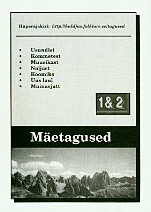Ristipuud lõuna-eesti matusekombestikus
Cross-trees in the South-Estonian funeral customs
Author(s): Marju Torp-KõivupuuSubject(s): Customs / Folklore
Published by: Eesti Kirjandusmuuseum
Summary/Abstract: A particular ritual belonging to traditional funeral customs of Hargla, Karula, Kanepi, Urvaste, Põlva, Rõuge and Räpina parish in the South - Estonia is cutting a cross on a tree when seeing off the deceased from home or chapel to the graveyard. Cross-tree ( Kreutzbaum (Germ); ristipuu, ristikko (Fin.); krestnoe derevo (Russ.) etc.) is known as a biggest tree at the (cross)road or a tree in the cross-forest to the stem of which the mourners ( the closest male relatives, godson, etc. in particular) cut a cross on the way to the graveyard. The earliest information about cross-trees or their similars reach to the 17th century. The systematic descriptions of tradition of cross-trees stored up in Estonian Literature Museums are rather late and derive from 19-th century. Today necessity of cross-cutting is motivated as followes: 1) religious imaginations ( cross-cutting is a part of prevention magic) or 2) following of an old tradition, whereas religious imaginations are missing ( the cross is cut a to tree because it is always done so) 3) in rare messages there are said that a cross is cut to a tree in the place where people have died in accident. In these texts there has not been worded religious imaginations according to which the soul of the deceased transferres into the tree growing at the place of accident. We can find cross-forests, crosstrees of a village and individual (family) cross-trees. Tradition of cross-cutting is made up of the following: choosing of cross-tree; cross-cutting; offering of traditional glass of vodka and snacks.
Journal: Mäetagused. Hüperajakiri
- Issue Year: 1996
- Issue No: 01-02
- Page Range: 55-74
- Page Count: 20
- Language: Estonian

